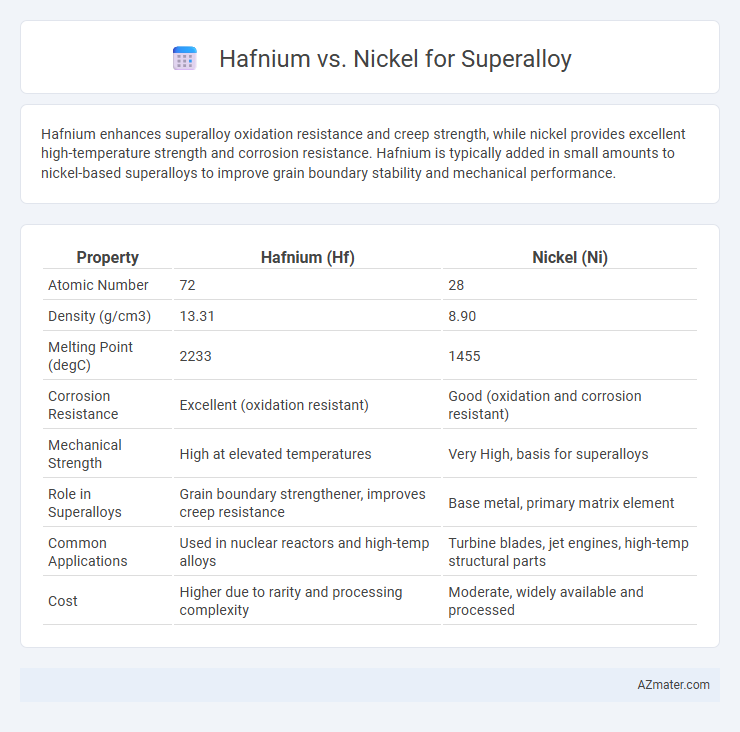Hafnium enhances superalloy oxidation resistance and creep strength, while nickel provides excellent high-temperature strength and corrosion resistance. Hafnium is typically added in small amounts to nickel-based superalloys to improve grain boundary stability and mechanical performance.
Table of Comparison
| Property | Hafnium (Hf) | Nickel (Ni) |
|---|---|---|
| Atomic Number | 72 | 28 |
| Density (g/cm3) | 13.31 | 8.90 |
| Melting Point (degC) | 2233 | 1455 |
| Corrosion Resistance | Excellent (oxidation resistant) | Good (oxidation and corrosion resistant) |
| Mechanical Strength | High at elevated temperatures | Very High, basis for superalloys |
| Role in Superalloys | Grain boundary strengthener, improves creep resistance | Base metal, primary matrix element |
| Common Applications | Used in nuclear reactors and high-temp alloys | Turbine blades, jet engines, high-temp structural parts |
| Cost | Higher due to rarity and processing complexity | Moderate, widely available and processed |
Introduction to Superalloys: Importance and Applications
Superalloys are high-performance metal alloys designed for extreme environments, predominantly used in aerospace, power generation, and chemical processing industries. Hafnium enhances superalloys by improving high-temperature strength, oxidation resistance, and creep resistance, while nickel serves as the primary matrix element providing excellent corrosion resistance and mechanical stability. The combination of hafnium and nickel in superalloys optimizes performance for turbine blades and other components exposed to severe thermal and mechanical stress.
Overview of Hafnium and Nickel in Superalloy Design
Hafnium enhances superalloy performance by improving oxidation resistance and grain boundary strength, critical for high-temperature aerospace applications. Nickel serves as the primary matrix element in superalloys, providing excellent corrosion resistance, toughness, and thermal stability. Incorporating hafnium into nickel-based superalloys optimizes mechanical properties and extends component lifespan under extreme operating conditions.
Chemical and Physical Properties: Hafnium vs Nickel
Hafnium exhibits a high melting point of about 2233degC and exceptional corrosion resistance, making it valuable in superalloys for high-temperature stability and oxidation resistance. Nickel, with a melting point of 1455degC and excellent ductility, provides superior mechanical strength and toughness, essential for maintaining alloy structural integrity under stress. The combination of hafnium's thermal stability and nickel's mechanical properties enhances superalloy performance in extreme aerospace and turbine engine environments.
High-Temperature Performance: A Comparative Analysis
Hafnium enhances superalloy performance at high temperatures by significantly improving oxidation resistance and mechanical strength, outperforming nickel in extreme environments. Hafnium's ability to stabilize the microstructure and retard grain boundary sliding makes it crucial for turbine blade coatings and jet engine components. Nickel, while providing excellent corrosion resistance and ductility, generally offers lower high-temperature creep resistance compared to hafnium-enriched superalloys.
Corrosion and Oxidation Resistance: Which Metal Excels?
Hafnium significantly enhances superalloy performance by forming stable oxide layers that improve oxidation resistance at high temperatures, outperforming nickel in this regard. Nickel, while inherently corrosion-resistant and able to form protective oxide films, is more prone to oxidation and degradation under extreme conditions compared to hafnium-containing superalloys. The superior corrosion and oxidation resistance of hafnium-enriched superalloys make them ideal for demanding aerospace and power generation applications.
Mechanical Strength and Creep Resistance
Hafnium significantly enhances the mechanical strength and creep resistance of superalloys due to its ability to stabilize the gamma prime (g') phase and grain boundaries at high temperatures. Nickel-based superalloys with hafnium additions exhibit improved oxidation resistance and maintain structural integrity under prolonged thermal stress compared to nickel alloys without hafnium. The presence of hafnium reduces grain boundary sliding and diffusion rates, resulting in superior creep performance critical for aerospace and turbine engine applications.
Cost and Material Availability Considerations
Hafnium is significantly more expensive and less abundant than nickel, impacting the cost-effectiveness of superalloy production where large quantities are required. Nickel, widely available and cost-efficient, remains a preferred base metal for superalloys due to its abundance and established supply chain. The high cost and limited availability of hafnium restrict its use primarily to critical applications requiring exceptional high-temperature strength and oxidation resistance.
Manufacturing Challenges and Machinability
Hafnium in superalloys offers superior high-temperature stability and oxidation resistance but introduces manufacturing challenges such as increased material brittleness and difficulty in casting due to its reactive nature. Nickel-based superalloys, widely used for their excellent mechanical strength and corrosion resistance, generally exhibit better machinability with established processing techniques and predictable tool wear rates. The incorporation of hafnium requires specialized machining strategies and advanced control of microstructure to mitigate tool degradation and maintain dimensional accuracy during complex manufacturing processes.
Environmental Impact and Sustainability
Hafnium and nickel, key elements in superalloy production, differ significantly in environmental impact and sustainability. Hafnium is less abundant and energy-intensive to extract, leading to higher ecological footprints, while nickel mining poses serious concerns due to greenhouse gas emissions and habitat destruction. Sustainable superalloy development prioritizes recycling and efficient usage of both metals to minimize environmental harm and resource depletion.
Conclusion: Selecting the Right Element for Superalloy Optimization
Hafnium enhances superalloy performance by improving oxidation resistance and grain boundary strengthening, making it ideal for high-temperature applications. Nickel serves as the primary matrix element, providing excellent creep resistance and corrosion resistance essential for turbine blades and jet engines. Selecting hafnium or nickel depends on the specific superalloy requirements, where hafnium optimizes durability under extreme conditions and nickel ensures overall structural stability and performance.

Infographic: Hafnium vs Nickel for Superalloy
 azmater.com
azmater.com